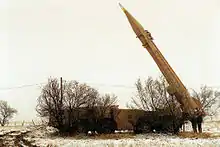Hwasong-6
The Hwasong-6 (Korean: 화성 6; Hanja: 火星 6) is a North Korean tactical ballistic missile. It is derived from the Hwasong-5, itself a derivative of the Soviet R-17 Elbrus. It carries the NATO reporting name Scud.
| Hwasong 6 | |
|---|---|
 | |
| Type | SRBM |
| Service history | |
| Used by | North Korea, Yemen, Syria, Iran, Myanmar, Egypt, Viet Nam |
| Wars | Yemeni Civil War (2015-present) |
| Production history | |
| Manufacturer | North Korea/Iran |
| Specifications | |
| Length | 12 m |
| Diameter | 0.88 m |
| Warhead | One |
| Engine | liquid |
Operational range | 500 km (310 mi)[1] |
Guidance system | inertial |
History
Work on an extended-range version of the Hwasong-5 began in 1988, and with only relatively minor modifications, a new type was produced from 1989, designated Hwasong-6 ("Scud Mod. C" or "Scud-C"). It was first tested in June 1990, and entered full-scale production the same year, or in 1991. It was superseded by the Rodong-1.
To increase range over its predecessor, the Hwasong-6 has its payload decreased to 770 kg (1,700 lb) and the length of the rocket body extended to increase the propellant by 25%; accuracy is 700–1,000 meters circular error probability (CEP).[2][3][4] Such range is sufficient to strike targets as far away as western Japan. Its dimensions are identical to the original Hwasong-5. Due to difficulties in procuring MAZ-543 TELs, mobile launchers were produced in North Korea. By 1999, North Korea was estimated to have produced 600 to 1,000 Hwasong-6 missiles, of which 25 had been launched in tests, 300 to 500 had been exported, and 300 to 600 were in service with the Korean People's Army.[5] Hwasong-6 was delivered to United Arab Emirates in 1999.[6]
Variant with terminal maneuverability was tested in May 2017.[7] U.S. intelligence referred to the upgraded missile as the KN-18.[8]
Export
The Hwasong-6 was exported to Iran, where it is designated as the Shahab-2, to Syria, where it is manufactured under licence with Chinese assistance[5] and to Yemen.[9]Myanmar also imported Scud-type Hwasong-6 ballistic missiles in 2009.[10]Uncertain status of Hwasong-6 export to Vietnam.[11]
See also
References
- "Archived copy" (PDF). Archived (PDF) from the original on 2017-02-25. Retrieved 2019-07-21.CS1 maint: archived copy as title (link)
- Hwasong-6 (Scud-C) short-range tactical ballistic missile Archived 2017-03-13 at the Wayback Machine - Armyrecognition.com
- ‘Scud C’ Variant (Hwasong 6) Archived 2016-10-26 at the Wayback Machine - Missilethreat.csis.org
- Scud-C Variant (Hwasong 6) Archived 2016-04-05 at the Wayback Machine - Missiledefenseadvocacy.org
- Bermudez, Joseph S. (1999). "A History of Ballistic Missile Development in the DPRK: Longer Range Designs, 1989-Present". James Martin Center for Nonproliferation Studies. Archived from the original on 2013-04-18. Retrieved 2008-02-14.
- https://www.oryxspioenkop.com/2020/11/inconvenient-arms-north-korean-weapons.html
- "Archived copy". Archived from the original on 2019-07-07. Retrieved 2019-07-21.CS1 maint: archived copy as title (link)
- North Korea’s New Short-Range Missiles: A Technical Evaluation. 38 North. 9 October 2019.
- "Archived copy". Archived from the original on 2018-03-17. Retrieved 2019-07-21.CS1 maint: archived copy as title (link)
- Min Lwin and Wai Moe (25 October 2020). "Junta Forms Missile Force to Guard Against External treats". Archived from the original on 25 October 2020. Retrieved 3 July 2010.
- https://mobile.twitter.com/ArmsControlWonk/status/974686166313189377
